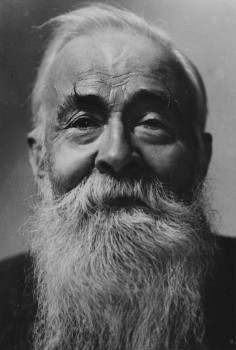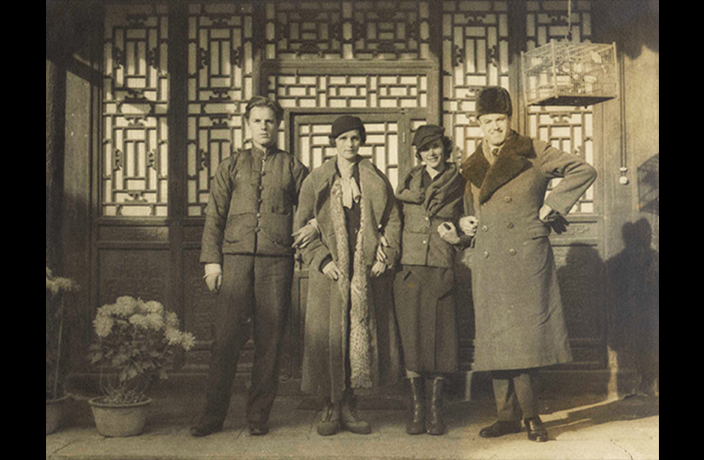Destination Peking is a companion book to my previously published Destination Shanghai. It’s similar in format – 18 tales of foreigners who spent time in Peking in the first half of the 20th Century. For some, the city would be home for most of their lives. For others, perhaps only a temporary visit – though one that profoundly affected their lives in some way.
It ranges from the rich and successful – such as the Woolworth’s heiress Barbara Hutton and her husband, the Prince Mdivani of the famous Russian emigre ‘Marrying Mdivanis’ – to the very poor – such as Mona Monteith, who worked in the city as a prostitute in the first year of the 20th Century – to the criminal.
One running theme throughout the stories is the presence of the unique hutong alleyways, which – depending on who you were – provided sumptuous homes, somewhere to hide, places to reinvent yourself or places to turn into temples to the Peking aesthetic.
Perhaps the best way to understand Peking and its history is to explore the city’s hutong. So here’s a few that feature in Destination Peking. If you want to know Peking, you need to know these hutong…
Tsui Hua Hutong
Where?
Now known as Cui Hua Hutong, it has survived in part running between Beiheyan Dajie and the north end of Wangfujing by Wusi Dajie. Sadly, the entire south side of the hutong is gone, though the northern portion of perhaps a dozen formerly intact courtyards remains. The Wangfujing end of the hutong is somewhat obscured by the constructions of the ominous black cube structure of the National Art Center and a hotel.
Who?
In 1934 it was home to some of the original and best ‘Hutong Hipsters.’ The English aesthete and independently wealthy aristocrat Desmond Parsons rented the largest courtyard on the hutong – No.8 – where he lived for several years.

Desmond Parsons (left) with his mother, sister-in-law, Anne Countess of Rosse, and Harold Acton, in front of Parsons’ Peking house, 1935
His good friend and travel writer Robert Byron arrived in the winter of 1935, where he stayed in a spare wing of the courtyard and wrote his classic travelogue, The Road To Oxiana.
When Chinese-American movie star Anna May Wong visited Peking in 1936, she begged to be able to rent No.8 Cui Hua Hutong, but Byron, who was house-sitting, refused. Still, she turned up to take photos…
Kung Hsien Hutong
Where?
Now known as Gongjian Hutong, the lane remains in a relatively decent state of repair, including its many xiong (or adjacent side alleys) running from Dianmen Dajie, north to south down the side of Beihai Park. It is close to Nanluoguxiang Hutong, though is far more intricate and charming than that tourist trap.

Gongjian Hutong in snow
Gongjian is an interesting hutong as it has a bend in the lane at either end, presumably to afford some additional privacy to the lane as well as prevent it from becoming a wind tunnel.
Who?
If you wanted a hutong where the cool aesthetes of 1930s Peking hung out talking history, poetry, opera and food, then Gongjian was the spot. Harold Acton – really the aesthete’s aesthete and a man who loved poetry, opera and theatre – lived on the hutong, while his friend, the famous Chinese opera performer Mei Lan-fang, lived nearby.

Acton in his courtyard in Chinese clothing
For Acton’s regular cocktail hour chums, such as Desmond Parsons, Robert Byron and Anna May Wong, Gongjian was just a 15-minute rickshaw ride across Jingshan Park from Cui Hua Hutong.
Kuei Chia Chang Hutong
Where?
Moving down south and closer to the old Legation Quarter. Once known in English as Armor Factory Alley, and today called Kuijiachang Hutong, the alley’s proximity to the foreign enclave of the Legation Quarter ensured it was always popular with foreigners.
It still exists close by the main Beijing Railway Station adjacent to the train line running east out of the city, and effectively in the shadow of the Dongbianmen watch tower (aka The Fox Tower). It ends at the Second Ring Road, near the Beijing Supreme People’s Court.
Who?
Kuijiachang Hutong keeps on cropping up in my research, again and again. It was where Pamela Werner and her father ETC Werner lived at No.1 before she was murdered in 1937. In Destination Peking, it is the home of Olga Fischer-Togo, once Peking’s best-known Western opera singer, who claimed to be a classically trained Viennese, but whose heritage was perhaps more Coney Island beer hall.
Paul French outside the former Snow residence
Peking, like Shanghai, is a city many foreigners would move to in order to reinvent themselves and obscure their pasts. It was also where Edgar ‘Red Star Over China’ Snow and his more talented journalist wife Helen Foster-Snow lived – there’s a commemoration near where the courtyard house they rented once stood.
Edgar Snow and Helen Foster-Snow in Peking
Edgar and Helen lived in Peking in the mid to late 1930s, and their Sunday afternoon soirees, that went on into the late evening, were legendary – bringing together revolutionaries, sinologists, visiting movie stars and all their good friends, both Chinese and foreign.

Helen Foster-Snow in Peking, 1935
Great Wool Alley
Where?
Close to Kuijiachang, and now called Dayangmao Hutong. The shortish hutong runs from Beijing Station Road East down to join Kuijiachang Hutong. Much favored by many foreigners as it was close to the ancient observatory, and, being within the boundaries of the old Tartar Wall, a short walk to the eastern edge of the Legation Quarter.
Who?
Dayangmao is a pretty run down and unprepossessing hutong now, but it has great importance in the development of Peking’s art scene. In the 1920s and 1930s, Japanese art collector Sotokichi Katsuizumi lived on the alley, and worked nearby at the Yokohama Specie Bank.
A young Japanese-American sculptor called Isamu Noguchi came to Peking in 1930, and his first acquaintance who showed him the city and its art scene was Katsuizumi. Noguchi also ended up renting a room on Dayangmao Hutong for a time, which he described as “splendid living.”

Isamu Noguchi
The house came complete with a houseboy who spoke French (as did Noguchi, at least somewhat), a cook, a rickshaw boy and their attendant families. Noguchi only stayed six months, but did study with the great Chinese calligrapher Qi Baishi. Noguchi eventually returned to the United States to emerge as one of America’s most enduring and innovative artists.

A work by Isamu Noguchi
Shih-Chia Hutong
Where?
In the 1920s, Shijia Hutong was one of the best kept and most exclusive addresses in Peking. It remains well maintained today and is the home of the Shijia Hutong Museum. Shijia, along with Nan-chi Tze Hutong and Kuijiachang, were just about the most desirable addresses in the city for foreigners who opted for hutong living.
Close to the commercial streets of Wangfuting (also known as Morrison Street and now Wangfujing) and Hatamen Street (now Chongwenmen Dajie), Shijia Hutong runs east to west between Dongsinan Dajie and Chaoyangmennan Dajie.
Who?
The quiet and leafy Shih-chia Hutong contains many well-built and large courtyard residences, attracting wealthy Chinese families and rich foreigners. In 1924, the American millionaire and would-be China Hand Herman Rogers and his wife Katherine moved into one of these courtyards, and then invited an old friend who was in town, Wallis Spencer, to stay with them for a while.
Wallis Spencer, who Wallis Simpson, later Duchess of Windsor
Wallis, who later divorced, remarried and took the name Simpson, before divorcing again and marrying a King, making her the Duchess of Windsor. She spent six months on the hutong collecting jade, playing bridge and conducting several love affairs.
Shih Fu Ma Ta Chieh
Where?
Heading West of the Forbidden City and across Tiananmen Square from Kujiachang Hutong, the lane of Shih Fu Ma Ta Chieh has been renamed Wenhua Hutong, and is just south of Fuxingmennei Dajie running off Naoshikou Dajie.
Who?
In the 1930s, a later generation of foreigners in Peking – Acton, Parsons, etc. – would favor the hutong west of the Forbidden City and away from the Legation Quarter and the more foreigner-dense eastern city. But in 1912, very few foreigners lived in this part of the city, or to the west of Tiananmen at all.
One did though. One of the most famous and notorious – Sir Edmund Backhouse, 2nd Baronet, also known as ‘The Hermit of Peking.’ Backhouse lived from 1912 for nearly a quarter of a century at No.19 Shih Fu Ma Ta Chieh. Around the same time, the New Culture Movement intellectual and early Chinese communist Li Ta-chao (Li Dazhao) lived on the same hutong.

Sir Edmund Backhouse, 2nd Baronet, also known as ‘The Hermit of Peking,’ pictured in 1919
Backhouse kept to himself, and many in the foreign community were rather nervous of him, while many Chinese marveled at his excellent language skills. Gossip swirled around him. It was said that a murder of a Chinese servant (and possibly his lover) at Shih Fu Ma Ta Chieh had occurred and been hushed up, and that while living there he had translated sensitive documents for the Soviets.
Yangjou Hutong
Where?
Now Yangrou Hutong, Mutton Alley, near The Church of the Savior, also known as the Xishiku Church or Beitang, in Xicheng District.
Who?
Backhouse again, but also a hutong well worth a stroll. Due to the Japanese invasion in 1937, Backhouse had to leave Wenhua Hutong and move to No.28 Yangjou Hutong, Mutton Alley, and now Yangrou Hutong, near The Church of the Savior, also known as the Xishiku Church or Beitang. Acton, who lived on the other side of Qianhai Lake, would see Backhouse when they were both out for their morning walks, though Backhouse would never acknowledge him.

Sir Edmund Backhouse in his later years
Kanyu Hutong
Where?
Also known as the Alley of the Sweet Rain to foreigners, and now Ganyu Hutong, just by Dongshikou subway station on Dongsinan Dajie.
Who?
Worth a visit as once many sojourning foreigners lived on this hutong, including Harold Acton’s great friend Osbert Sitwell of the rather generously talented Sitwell family. From Ganyu Hutong, he explored the opera houses and temples of Peking, where he once met a former Imperial Palace eunuch, a wrinkled and hairless man with a piping voice who enquired of Sitwell:
“Tell me, young man, do you have no group of people (eunuchs) like us where you come from?” Sitwell considered the eunuch’s question and then replied, “Yes, indeed we have. We call it Bloomsbury.”
 Osbert Sitwell
Osbert Sitwell
For more history stories, click here. For more on Paul French, click here. To buy Paul French’s ‘Destination Peking,’ click here or scan the QR code:

[All images courtesy of Paul French]


























0 User Comments